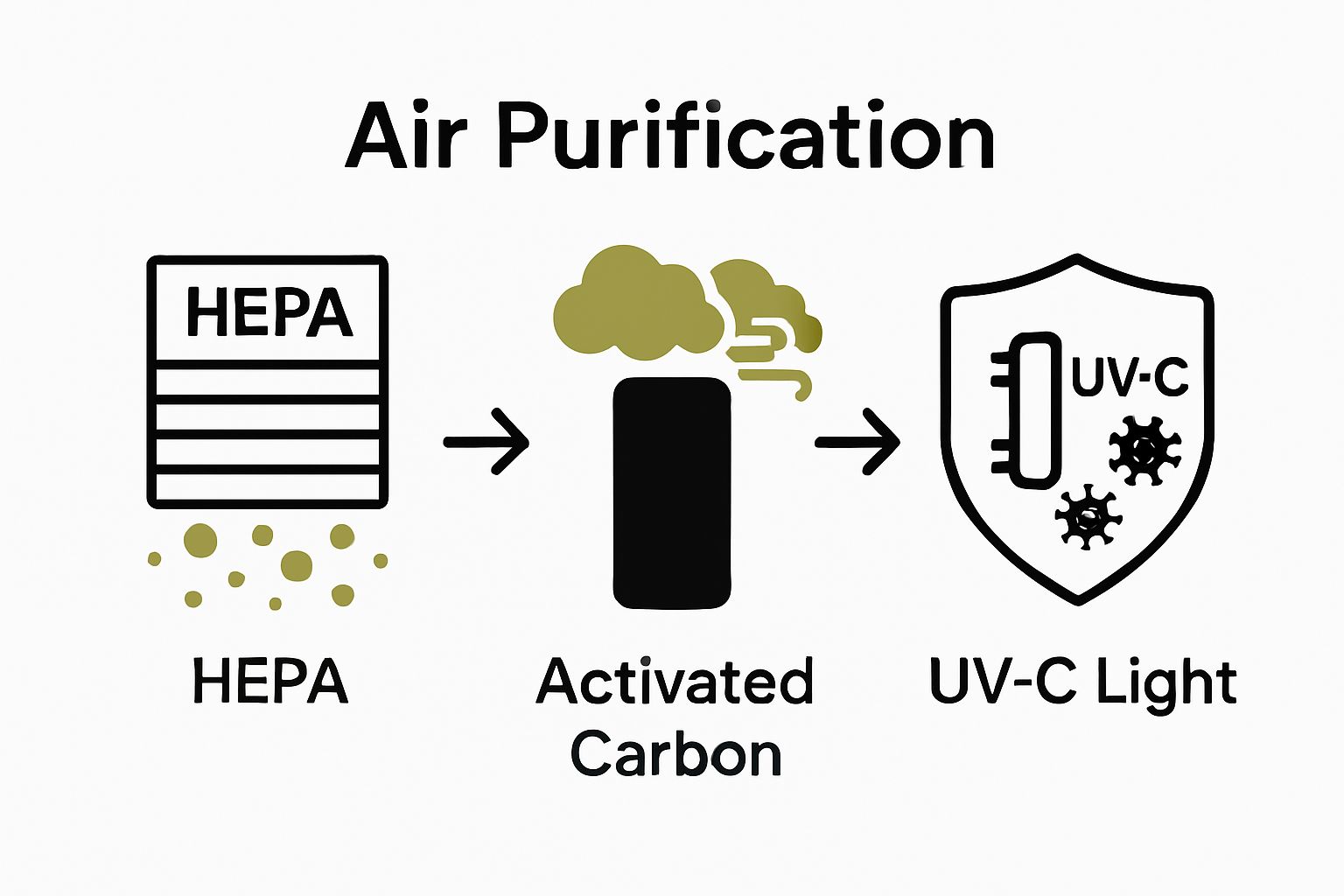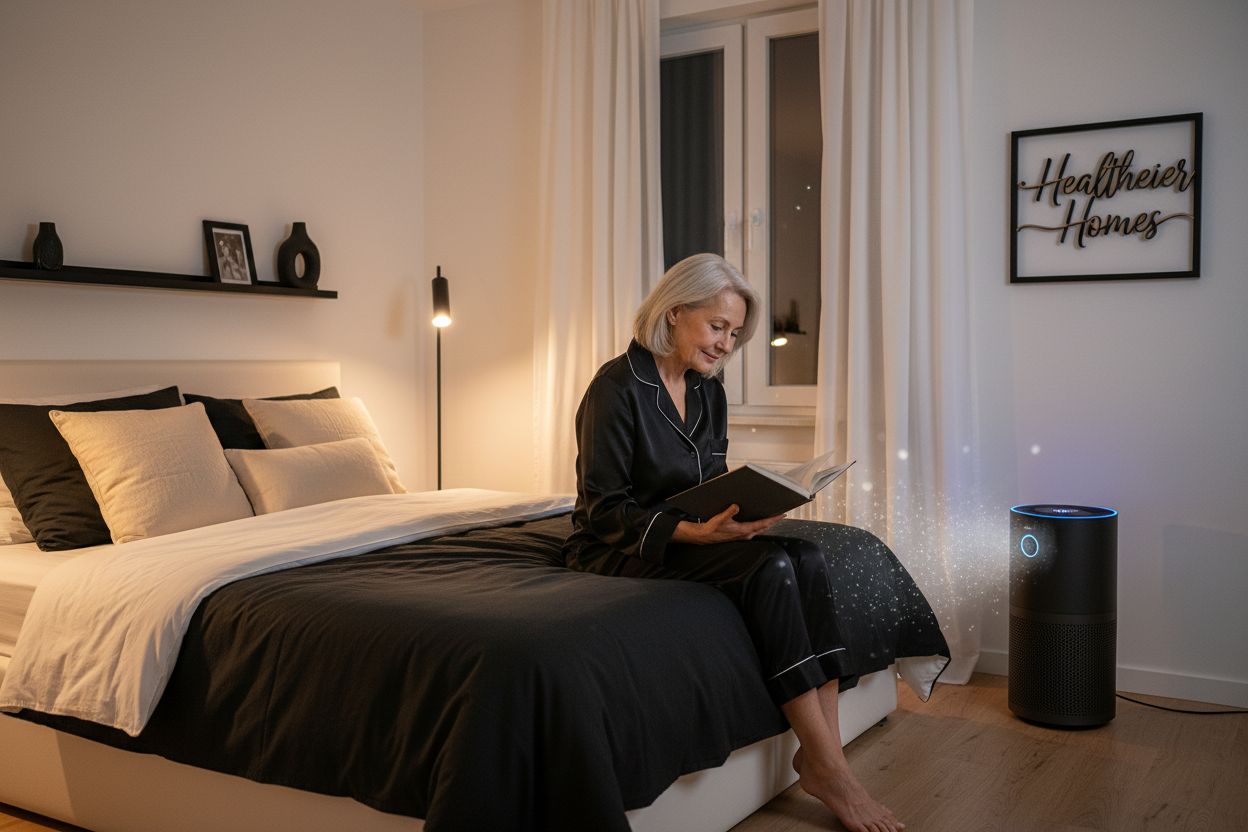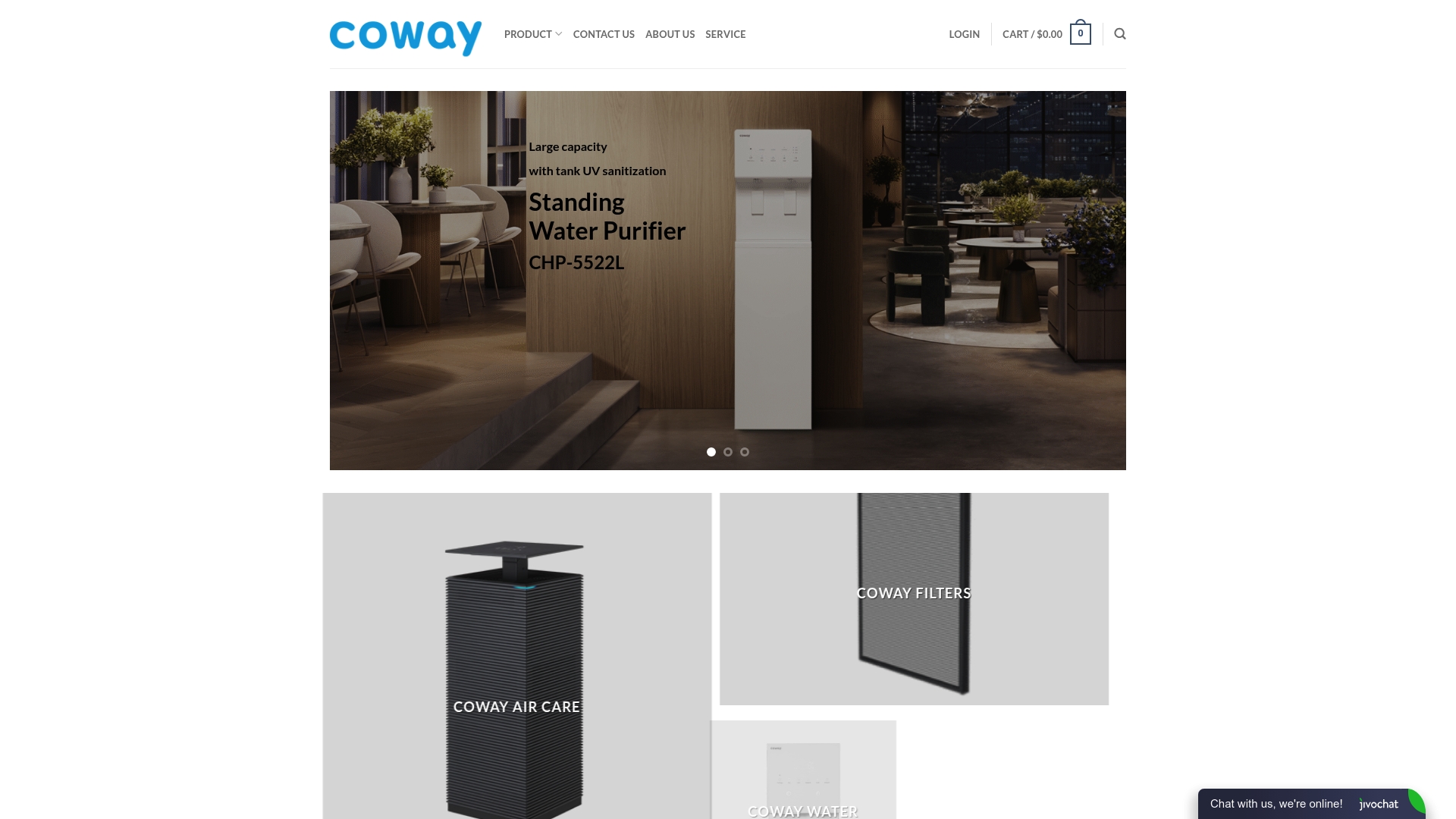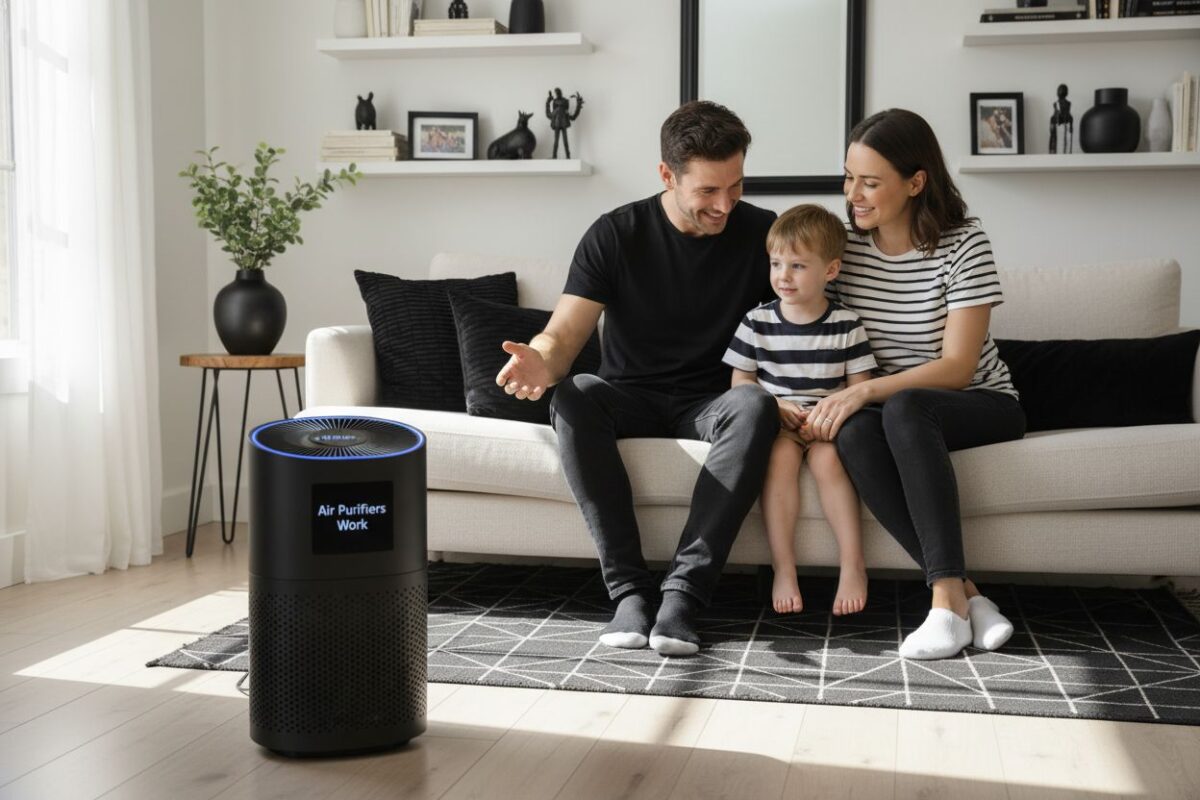Uncategorized
Understanding How Air Purifiers Work for Healthier Homes
Air purifiers are changing the way we think about home comfort and health. Almost 90 percent of our daily lives are spent indoors, according to health experts, yet most people never realize just how many unseen pollutants might be filling the air in their homes. The real surprise is that clean indoor air is not just about making your house smell fresh. It is quietly protecting your body from invisible threats that could impact you for years to come.
Table of Contents
- What Are Air Purifiers And Their Purpose?
- Why Clean Air Matters For Your Health And Comfort
- Key Technologies Behind Air Purifiers
- How Filtration Systems Operate In Air Purifiers
- Real-World Benefits Of Using Air Purifiers
Quick Summary
| Takeaway | Explanation |
|---|---|
| Air purifiers improve indoor air quality. | Designed to remove pollutants, air purifiers are essential for healthier breathing environments, especially for sensitive individuals. |
| Multiple filtration technologies enhance effectiveness. | Advanced models combine HEPA, activated carbon, and UV-C light to target various contaminants, ensuring comprehensive air cleaning. |
| Poor air quality poses serious health risks. | Continuous exposure to indoor pollutants can lead to respiratory and cardiovascular diseases, particularly affecting vulnerable populations. |
| Air purifiers provide immediate health benefits. | They help reduce allergens and pathogens, improving conditions for asthma sufferers and allergy sufferers more efficiently. |
| Understanding filter types aids in smart buying choices. | Knowledge of filtration methods helps consumers select air purifiers tailored to their unique indoor air quality needs. |
What are Air Purifiers and Their Purpose?
Air purifiers are advanced indoor air treatment devices designed to remove contaminants, pollutants, and potential health hazards from the surrounding atmosphere. The U.S. Environmental Protection Agency defines these devices as critical tools for improving indoor air quality, particularly beneficial for individuals with respiratory sensitivities like asthma or allergies.
The Core Function of Air Purification
At their fundamental level, air purifiers work by drawing in ambient air, passing it through multiple filtration stages, and releasing cleaned air back into the environment. These devices capture various airborne particles that can potentially harm human health, including:
- Dust and fine particulate matter
- Pollen and allergen particles
- Pet dander
- Smoke and tobacco residues
- Microscopic bacteria and viruses
- Volatile organic compounds (VOCs)
By systematically filtering these contaminants, air purifiers create a healthier indoor breathing environment. The most sophisticated models utilize multiple filtration technologies to maximize air cleaning efficiency.
Health and Environmental Benefits
Air purifiers serve more than just a cosmetic purpose. They provide substantial health benefits by reducing exposure to airborne pollutants that can trigger respiratory issues, allergic reactions, and long-term health complications. For individuals living in urban areas with high pollution levels or those with preexisting respiratory conditions, these devices offer a critical line of defense.
If you want to learn more about indoor air quality management, our comprehensive guide provides deeper insights into how these innovative devices protect your living spaces.
Why Clean Air Matters for Your Health and Comfort
The National Institute of Environmental Health Sciences highlights the profound impact of indoor air quality on human health, revealing that we spend approximately 90% of our time indoors, making air quality a critical factor in our overall wellness. Clean air is not just a luxury but a fundamental necessity for maintaining optimal physical and mental health.
The Hidden Risks of Poor Indoor Air Quality
Indoor air can harbor numerous invisible threats that significantly impact our well-being. These pollutants originate from multiple sources within our living and working spaces, creating a complex environment of potential health risks:
- Volatile organic compounds (VOCs) from cleaning products
- Particulate matter from cooking and heating systems
- Biological contaminants like mold spores and dust mites
- Chemical emissions from furniture and building materials
- Pet dander and outdoor pollutants that enter indoor spaces
Continuous exposure to these contaminants can lead to serious health complications, ranging from mild respiratory irritations to more severe chronic conditions.
Long-Term Health Implications
Beyond immediate discomfort, poor air quality can have substantial long-term health consequences. Chronic exposure to indoor air pollutants has been linked to increased risks of respiratory diseases, cardiovascular problems, and compromised immune system function. Children, elderly individuals, and those with preexisting health conditions are particularly vulnerable.
To enhance your understanding of indoor air quality management, our comprehensive resources provide detailed insights into protecting your living environment. By prioritizing clean air, you invest in your immediate comfort and long-term health resilience.
Key Technologies Behind Air Purifiers
Groundbreaking research in air purification technologies reveals a sophisticated landscape of innovative filtration methods designed to combat indoor air contamination. Modern air purifiers employ multiple advanced technologies to comprehensively clean and improve indoor air quality, each targeting specific types of pollutants with precision and efficiency.
Filtration Technology Fundamentals
Air purifiers utilize several core filtration technologies that work synergistically to remove different types of airborne contaminants:
- HEPA Filters: Capture microscopic particles as small as 0.3 microns
- Activated Carbon Filters: Absorb odors and harmful chemical vapors
- UV-C Light Technology: Neutralizes bacteria and viruses
- Ionization Systems: Charge and remove airborne particles
- Electrostatic Precipitators: Trap extremely fine particulate matter
Each technology serves a unique purpose, creating a multi-layered approach to air purification that addresses various environmental pollutants.
Below is a comparison table summarizing the main air purifier technologies discussed and the specific pollutants each targets. This helps clarify which technology addresses which indoor air threat.
| Air Purification Technology | Targeted Contaminants | Key Function |
|---|---|---|
| HEPA Filters | Dust, pollen, pet dander, bacteria, viruses | Captures microscopic particles (≥0.3 µm) |
| Activated Carbon Filters | Odors, volatile organic compounds (VOCs) | Absorbs harmful chemicals and odors |
| UV-C Light Technology | Bacteria, viruses | Neutralizes microbiological contaminants |
| Ionization Systems | Fine airborne particles | Charges and removes airborne pollutants |
| Electrostatic Precipitators | Ultrafine particles | Traps extremely fine contaminants |

Advanced Purification Mechanisms
The most sophisticated air purification systems combine multiple technologies to maximize air cleaning efficiency. For instance, a comprehensive system might integrate HEPA filtration with activated carbon and UV-C light, providing comprehensive protection against particulates, gases, and microbiological contaminants.
If you want to explore the intricacies of filtration technology, our detailed guide offers deeper insights into how these innovative systems protect your indoor environment. Understanding these technologies empowers consumers to make informed choices about air purification solutions tailored to their specific needs.
How Filtration Systems Operate in Air Purifiers
Research from Indoor Air Quality experts reveals that effective air purification relies on complex, multi-stage filtration processes designed to systematically remove different types of airborne contaminants. These sophisticated systems transform indoor air quality through precision engineering and strategic particle interception.
Air Flow and Filtration Mechanics
Air purifiers operate through a consistent and methodical process that involves drawing contaminated air through multiple filtration layers:
- Intake Stage: A powerful fan pulls surrounding air into the device
- Pre-Filtration: Large particles like dust and hair are captured initially
- Primary Filtration: HEPA or advanced filters trap microscopic contaminants
- Secondary Treatment: Activated carbon or UV light neutralizes remaining pollutants
- Clean Air Discharge: Purified air is released back into the environment
This sequential approach ensures comprehensive air cleaning, addressing different pollution types with targeted technological interventions.
The following table outlines the typical filtration stages air passes through in a modern air purifier, providing a clear overview of each step and its main purpose in the purification process.
| Filtration Stage | Main Purpose | Example Contaminants Targeted |
|---|---|---|
| Intake Stage | Pulls indoor air into the purifier | General room air |
| Pre-Filtration | Captures larger particles | Dust, hair |
| Primary Filtration | Traps microscopic contaminants | Pollen, bacteria, viruses |
| Secondary Treatment | Neutralizes remaining pollutants | VOCs, odors, pathogens |
| Clean Air Discharge | Releases purified air back to the room | N/A |
Precision Particle Interception
The core effectiveness of filtration systems lies in their ability to intercept particles of varying sizes. Advanced air purifiers utilize intricate filter designs that can capture contaminants as small as 0.1 microns, including bacteria, viruses, and ultrafine dust particles. Different filter media interact with pollutants through mechanical trapping, electrostatic attraction, and chemical adsorption.
Learn more about understanding filter technologies and how they protect your indoor environment against microscopic threats. By comprehending these intricate mechanisms, consumers can make informed decisions about selecting the most effective air purification solutions.
Real-World Benefits of Using Air Purifiers
Comprehensive research from the National Institutes of Health demonstrates that air purifiers offer substantial real-world health and environmental advantages beyond theoretical capabilities. These devices have proven transformative in creating healthier indoor environments across diverse settings, from residential homes to professional workspaces.
Health Impact and Respiratory Protection
Air purifiers provide critical protection for individuals with respiratory sensitivities and those living in environments with compromised air quality:
- Asthma Management: Reduce airborne triggers and allergen concentrations
- Allergy Relief: Minimize exposure to pollen, pet dander, and dust mites
- Immune System Support: Decrease potential pathogen transmission
- Sleep Quality Improvement: Create cleaner breathing environments
- Stress Reduction: Mitigate environmental health concerns
By systematically removing microscopic contaminants, these devices offer a proactive approach to personal health maintenance.

Environmental and Lifestyle Benefits
Beyond individual health advantages, air purifiers contribute to broader environmental and lifestyle improvements. They effectively neutralize odors, eliminate secondhand smoke particles, and create more hygienic living spaces. For families with children, elderly members, or individuals with compromised immune systems, air purifiers represent an essential investment in preventative wellness.
Learn more about commercial air purifier advantages and discover how these innovative technologies can transform your indoor environment. Understanding their comprehensive benefits empowers consumers to make informed decisions about air quality management.
Breathe Easier with Coway: Turn Clean Air Insights into Action
You have just learned how invisible air contaminants and allergens silently threaten your comfort and health. The article highlights the risks posed by dust, pollen, VOCs, and airborne bacteria in your home environment. You deserve more than temporary relief from these issues. You deserve a real solution backed by advanced filtration technology and proven science. Explore our wide range of air purifiers designed specifically for homes that value wellness and clean living. Find in-depth product details and trusted advice to help you make the right choice by visiting our Uncategorized Air Purifiers Collection.

Take charge of your air quality today. Browse Coway’s official site to see innovative air purifiers featuring multi-stage HEPA filtration, UV sanitization, and worry-free maintenance. Secure a fresher, healthier home for your family right now. Your path to pure air and peace of mind starts with a single click.
Frequently Asked Questions
How do air purifiers work to improve indoor air quality?
Air purifiers improve indoor air quality by drawing in contaminated air, filtering it through multiple stages, and releasing cleaner air back into the environment. To benefit from clean air, run your air purifier continuously, especially in high-traffic areas or during allergy season.
What types of particles can air purifiers remove from my home?
Air purifiers can remove a variety of particles including dust, pollen, pet dander, smoke, bacteria, and volatile organic compounds (VOCs). Select an air purifier equipped with HEPA and activated carbon filters to effectively capture these contaminants and enhance your living space’s air quality.
How often should I change the filters in my air purifier?
You should change the filters in your air purifier every 6 to 12 months, depending on usage and the type of filters used. Regularly check the filter indicator on your device or follow the manufacturer’s guidelines to ensure optimal purification efficiency.
Can air purifiers help with allergy symptoms?
Yes, air purifiers can significantly reduce allergy symptoms by capturing airborne allergens such as pollen and dust mites. Consider running your air purifier in your bedroom at night, which may help alleviate allergy symptoms and improve sleep quality.
Is it necessary to use air purifiers in every room?
While it’s not necessary to use air purifiers in every room, placing one in common areas like living rooms and bedrooms can enhance your overall indoor air quality. Use a purifier in each high-use room to maximize the benefits, aiming for cleaner air throughout your home.
How can I tell if my air purifier is working effectively?
You can identify effective air purification by noticing improvements in your indoor air quality, such as reduced odors and fewer allergy symptoms. Additionally, monitor the filter indicators or replacement signals, and check for dust accumulation in your living spaces to gauge performance.
Recommended
- What is a HEPA Filter? Understanding Its Importance – Coway Water Purifier
- Understanding Indoor Pollutants and Air Purifiers – Coway Water Purifier
- 8 Indoor Air Quality Tips for a Healthier Home – Coway Water Purifier
- Understanding Air vs Water Purifiers: Key Differences Explained – Coway Water Purifier
- Why Indoor Air Quality Testing Matters for Your Home and Health

